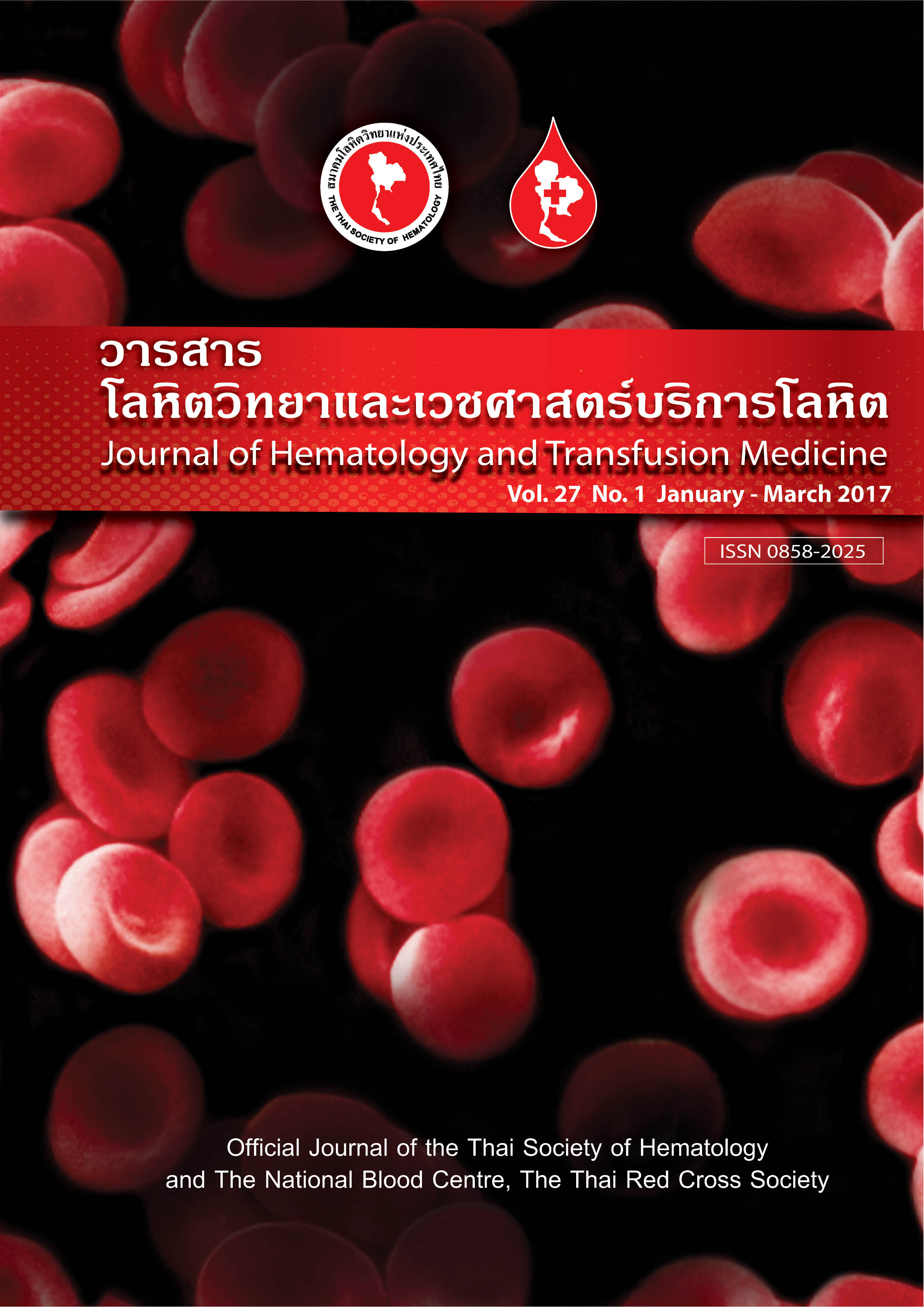การตรวจกรองแอนติบอดีและความชุกของแอนติบอดีชนิดต่างๆ ในผู้ป่วยที่ขอใช้เลือดของโรงพยาบาลศรีนครินทร์
Keywords:
Unexpected antibodies, LISS/gel test, Antibody screening testAbstract
บทคัดย่อ
การตรวจกรองแอนติบอดีต่อแอนติเจนของเม็ดเลือดแดง มีความสำคัญในกระบวนการเตรียมเลือดให้แก่ผู้ป่วย เมื่อมีการตรวจพบแอนติบอดีที่มีความสำคัญทางคลินิก จำเป็นต้องให้เลือดที่ไม่มีแอนติเจนชนิดนั้นแก่ผู้ป่วย วัตถุประสงค์ เพื่อหาความชุกและชนิดของแอนติบอดีที่พบในผู้ป่วยที่ขอใช้เลือดของโรงพยาบาลศรีนครินทร์ วิธีการ เป็นการศึกษาย้อนหลัง โดยแบ่งผู้ป่วยเป็นสองกลุ่ม กลุ่มแรกจำนวน 15,268 ราย ทำการตรวจกรองแอนติบอดีด้วยเทคนิค saline ร่วมกับเทคนิคเอนไซม์ โดยใช้ screening cells ที่เตรียมขึ้นเองจำนวน 2 ราย และกลุ่มที่สองจำนวน 56,083 ราย ทำการทดสอบด้วยเทคนิค LISS/gel test โดยใช้ screening cells สำเร็จรูปจำนวน 2 ราย และเตรียมขึ้นเองจำนวน 1 ราย ผลการศึกษา พบว่าการตรวจกรองแอนติบอดีในกลุ่มแรกให้ผลบวกร้อยละ 6.86 แอนติบอดีที่พบมาก 2 อันดับแรกคือ anti-Lewis จำนวน 393 ราย (37.50%) และ anti-P1จำนวน223ราย(21.28%) ส่วนกลุ่มที่สองให้ผลบวกร้อยละ 4.71 แอนติบอดีที่พบบ่อยคือ anti-Mia จำนวน 324 ราย (25.86%) และ anti-E จำนวน 259 ราย (20.67%) สรุป จากผลการศึกษานี้จะเห็นได้ว่าในการตรวจกรองแอนติบอดีโดยใช้ เทคนิค LISS/gel test จะพบแอนติบอดีที่มีความสำคัญทางคลินิกได้มากกว่าเทคนิค saline และเอนไซม์ ทั้งนี้เนื่องจากความแตกต่างทางเทคนิค แอนติเจนบน screening cells ที่ใช้ในการตรวจกรอง และกลุ่มผู้ป่วย ดังนั้นการตรวจกรองแอนติบอดีในผู้ป่วยควรเลือกวิธีการทดสอบและ screening cells ให้เหมาะสม เพื่อช่วยในการตรวจหาแอนติบอดีและการเตรียมเลือดที่เป็นแอนติเจนลบที่เข้ากันได้กับผู้ป่วยต่อไป
Abstract:
The detection of clinically significant alloantibodies to red cell antigens are important in the process of compatibility testing before blood transfusion. When the patient is found to have clinically significant alloantibody, red blood cell units should lack the antigens that correspond to those antibodies. Aims: To determine the prevalence and specificity of unexpected antibodies in the patients of Srinagarind hospital. Methods: This study was a retrospective study carried out at Blood Transfusion Center, Faculty of Medicine, Khon Kaen University. The data from patients were reviewed and separated into two groups, the first group,15,268 samples were screened with two in house screening cells by saline and enzyme tube techniques. The second group, 56,083 samples were tested with two commercial cells and one in house screening cells by LISS/gel test. Results: In the first group, 1,048 (6.86%) sera were positive antibody screening test. The most common antibodies were antibodies of Lewis system, 393 (37.50%) and anti-P1 223 (21.28%). By using LISS/gel test in the second group, 1,253 (4.71%) sera were positive. Anti-Mia 324 (25.86%) and anti-E 259 (20.67%) were commonly found. Conclusion: The results showed that clinically significant unexpected antibodies were found in LISS/gel test more than saline and enzyme tube test which may be due to the difference in screening cells, techniques and patient groups. Therefore, the selection of the appropriate techniques and screening cells for antibody detection is beneficial to determine antibody specificity and to provide antigen negative red cell compatible donors to the patients.


